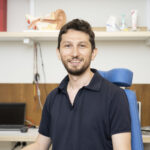Link to Pubmed [PMID] – 32862243
Link to DOI – 10.1007/s00415-020-10186-x
J Neurol 2021 Feb; 268(2): 526-531
To find out if Charcot-Marie-Tooth (CMT) patients, who have peripheral vestibular as well as peripheral somatosensory impairment, have worse postural balance than those who do not.We studied 32 patients with various CMT phenotypes and genotypes. Vestibular function was measured with the video head impulse test (vHIT) which tests vestibulo-ocular reflex (VOR) gain from each of the six semicircular canals in response to rapid head rotations. Postural balance was evaluated with a battery of four postural tests with emphasis on the modified clinical test of sensory integration in balance (mCTSIB).Half of the 32 patients had some impairment of vestibular function ranging from mild, affecting only 1-2 semicircular canals, to almost total affecting all 6 semicircular canals. Their mCTSIB scores correlated with VOR gain from the vertical rather than from the lateral semicircular canals. The worse the vertical VOR gain the worse the mCTSIB score.We propose that any CMT patient could have clinically inapparent vestibular impairment that can be easily measured with the vHIT. This vestibular impairment could be contributing to their imbalance and could respond to a focused vestibular rehabilitation program.
